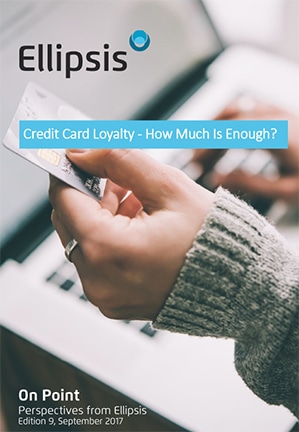
In most developed markets, funding for credit card loyalty programs is most often tied to the card’s interchange fee – the fee paid by merchants accepting the card to the card issuer. This widespread practice of linking interchange to loyalty funding has seen interchange fees mostly or wholly funding credit card reward programs – an especially important practice given the increasing reluctance of merchants to pay issuers for points. Given this reality, how can looking at market differences in interchange rates help card marketers understand how much loyalty funding is enough, and how we can do more with less? In this month’s Spotlight, Ellipsis & Company managing partner Tim Tyler helps us navigate the credit card loyalty landscape.
By Tim Tyler
In a recent discussion about credit card reward funding, Iain Turnbull from National Australia Bank told me, “There is not enough interchange in the United Kingdom to run the credit card loyalty programs we have historically. There is just enough interchange in Australia. Somewhere between the two is an interchange threshold critical to how credit card loyalty programs reward customers.”
In some developed economies, regulators have forcibly reduced interchange, while self-regulation has reduced it in others. Because interchange rates have become more transparent, it is now possible to infer a market’s budget for credit card loyalty programs – and this transparency affords us a unique opportunity to explore differences in credit card loyalty program marketing based on differences in overall budgets. Around the world, therefore, there is a large-scale test underway of the effect of falling loyalty program budgets on the marketing, structure, and generosity of a whole class of consumer loyalty programs. The results of that test will, at the very least, tell us something about how marketers innovate and react to budget stress.
In our market research, we divided credit card loyalty marketers into four primary categories: Very low interchange markets such as the UK, with 0.3% interchange due to EU regulations; Low interchange markets such as Australia, with 0.5% interchange due to central bank regulation; “regular” markets such as New Zealand, where interchange varies but is generally higher than Australian rates; and high interchange markets such as the U.S, with approximately 2.4% interchange. We then looked at how credit card marketers in each market were working with their respective interchange to fund and market loyalty programs. Here’s what we found:
The United Kingdom (0.3% interchange): Rewarding “whole bank” relationships
With limited funds but a good mechanism for reward available in the credit card product, UK banks place more emphasis on the cardholder’s overall relationship with the bank. Points for mortgages, points for direct deposit, points for direct debits… there is a broadening of the product base used to fund loyalty within the bank. Increasing the depth of product holdings and engagement, for example, seems to be the aim of banks such as Natwest and Santander. Other banks implement higher annual fees, higher interest rates, and points earning caps to compensate for lower interchange; Capital One, on the other hand, simply withdrew its rewards cards from the UK, saying the proposition was unsustainable.
Australia (0.5% interchange): Pretending while cutting
The picture in Australia is complicated by the presence of the Qantas Frequent Flyer program, in which points are earned on 35 percent of all credit card spend. Issuers have cut the richness of their loyalty programs by as much as 62 percent in some cases, but do not want to lose the big-spending air points collectors from their portfolio. To compensate for these cuts, banks have continued to promote their programs, and have released travel-specific cards that offer travel benefits in lieu of points. They obfuscate while increasing fees, tightening earning caps, and increasing the points cost of rewards. This risky strategy could see cardholders abandon these programs through boredom.
New Zealand (medium interchange): Disruption and innovation
In New Zealand, there has been a period of voluntary restraint on increasing interchange, but that restraint has not shielded the market from interesting times. Two years ago, Air New Zealand changed its relationship with the Bank of New Zealand and withdrew the popular Global Plus Airpoints card; Air New Zealand is now aggressively building a network of retail partners to build a robust Airpoints coalition program that will compete with the existing national coalition program Fly Buys. As a result, other issuers are revitalizing their proprietary programs, and there will be lessons for us all in an environment where loyalty budgets are still rich enough to influence cardholder choices.
USA (2.4% interchange): Everyday spend rules
With loyalty program funding this rich, US card marketers focus on getting their cards to the front of the cardholder’s wallet. They do this by reinforcing habitual use of everyday shopping. High earn rates for card use in supermarkets, gas stations, and drug stores are common, with large issuers willing to subsidize rewards in these categories well above the 2-plus percent interchange. The venerable US market also features a large number of co-branded and affinity cards, with retail brands hungry to share substantial card returns with issuers.
Are there lessons that jump out in this quick comparison? A few for your consideration:
- For very low interchange markets, stress wider banking relationships to increase program budgets via other business units helping to fund the program.
- For low interchange markets, consider ways to counterprogram against “stingy” reward programs, or consider following UK banks’ lead by evolving toward “whole bank” relationships.
- For medium interchange markets, follow the New Zealand model of revitalizing proprietary programs to compete against frequent-flyer programs and coalitions.
- For rich interchange markets, reinforce habitual use by cardholders through everyday spend rewards to keep your card front of wallet.
In each of these markets, issuers are experimenting to determine how much funding is enough while trying to do more with less. To innovate, marketers should continue to learn through observation, share ideas, and look for successful case studies outside your native market. We’ll continue to share our findings with you.
Tim Tyler is Managing Partner for Ellipsis & Company. This content is sponsored by Ellipsis & Company; for more information, please download their white paper here.


